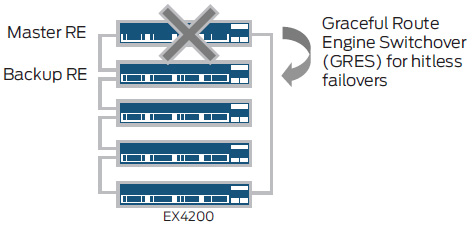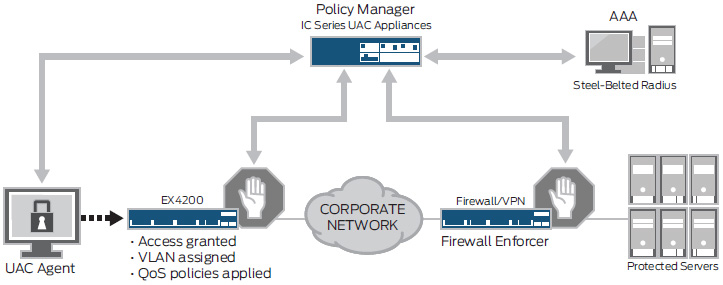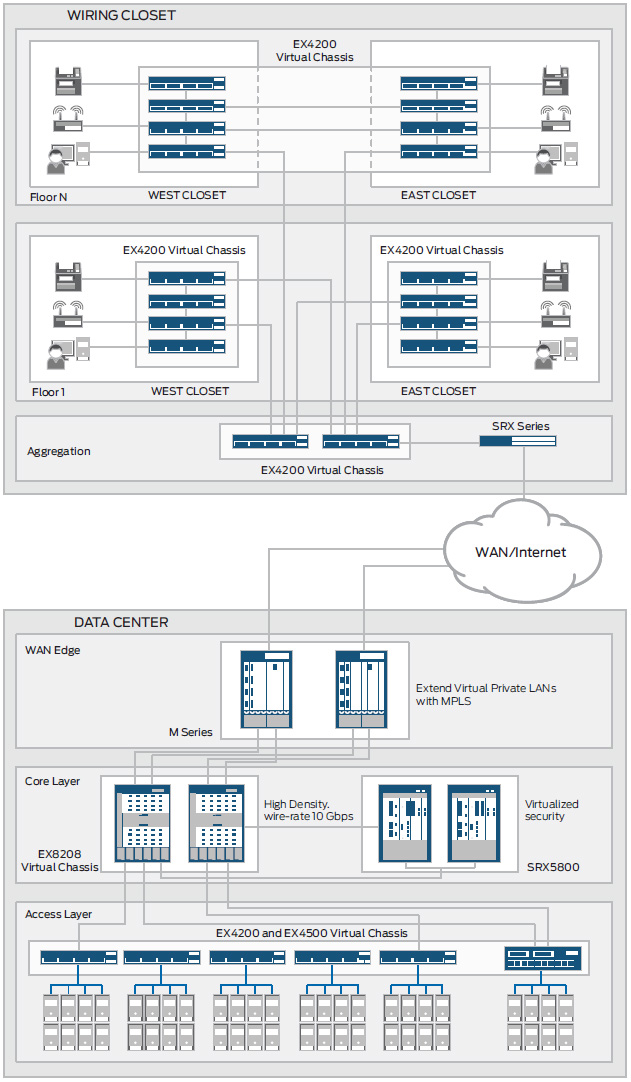EX4200-48P Overview:
The EX4200 switches with Virtual Chassis technology combine the availability and reliability of modular systems with the economics and flexibility of stackable switches, delivering a high-performance, scalable solution for data center and campus environments.
High-performance businesses demand high-performance networking solutions. These solutions include a new class of secure, scalable and always-on enterprise switch that advances the economics of networking by enabling businesses to deploy innovative new technologies that increase revenue and improve productivity. The Juniper Networks EX4200 line of Ethernet switches with Virtual Chassis technology combine the compact, pay-as-you-grow economics and low power and cooling requirements of stackable switches with the performance, availability, operational ease and port densities of chassis-based platforms to meet the demands of today’s high-performance enterprises.
The Juniper Networks EX4200 line of Ethernet switches with Virtual Chassis technology combine the high availability (HA) and carrier-class reliability of modular systems with the economics and flexibility of stackable platforms, delivering a high-performance, scalable solution for data center, campus and branch office environments.
Offering a full suite of Layer 2 and Layer 3 switching capabilities as part of the base software, the EX4200 satisfies a variety of high-performance applications, including branch, campus and data center access deployments as well as Gigabit Ethernet (GbE) aggregation deployments. A single 24-port or 48-port switch can be deployed initially; as requirements grow, Juniper Networks Virtual Chassis technology allows up to 10 EX4200 switches to be interconnected over a 128 gigabit-per-second (Gbps) backplane and managed as a single device, delivering a scalable, pay-as-you-grow solution for expanding network environments. Flexible Gigabit Ethernet (GbE) and 10-Gigabit Ethernet (10 GbE) uplink options enable high-speed connectivity to aggregation- or core-layer switches which connect multiple floors or buildings.
All EX4200 switches include HA features such as redundant, hot-swappable internal power supplies and field-replaceable, multi-blower fan trays to ensure maximum uptime. In addition, the base EX4200 switch models offer Class 3 Power over Ethernet (PoE), delivering 15.4 watts on the first eight ports to support networked devices such as telephones, video cameras and wireless LAN (WLAN) access points for low-density converged networks. Full PoE options delivering 15.4 watts on all 24 or 48 ports are also available, making them ideal for high-density IP telephony deployments.
Juniper Networks Virtual Chassis Technology: Chassis-like Switch Features in a Stackable Form Factor
- Redundant, internal hot-swappable power supplies
- Hot-swappable fan tray with redundant blowers
- Consistent modular JUNOS Software control plane feature implementation
- Dual Route Engines with Graceful Routing Engine Switchover (GRES)
- Single management interface
- Easy, centralized software upgrades
- Scales from 24 to 480 ports with up to 20 10 GbE uplinks
Each EX4200 switch includes an integrated application-specific integrated circuit (ASIC)-based Packet Forwarding Engine, the EX-PFE, while an integrated Routing Engine (RE) delivers all control plane functionality. Based on field-proven Juniper Networks technology, the Route Engine brings the same level of carrier-class performance and reliability to the EX4200 line of Ethernet switches that Juniper Networks routers bring to the world’s largest service provider networks.
The EX4200 also leverages the same modular Juniper Networks JUNOS Software as Juniper Networks router products, ensuring a consistent implementation and operation of each control plane feature across an entire Juniper Networks infrastructure.
Architecture and Key Components
The EX4200 switches are single rack-unit devices that deliver a compact solution for crowded wiring closets and access switch locations where space and power are at a premium. Each EX4200 supports optional front-panel uplink modules offering either four GbE ports or two 10 GbE ports for high-speed backbone or link-aggregation connections between wiring closets and upstream aggregation switches. Uplink modules can be installed without powering down the switch, enabling users to add high-speed connectivity at any time or migrate from one uplink type to the other to deliver the ultimate in flexible, high-performance interconnectivity.
The EX4200 also features a front-panel LCD display that offers a flexible interface for performing device bring-up and configuration rollbacks, reporting switch alarm and LED status, or restoring the switch to its default settings. The LCD also displays a Virtual Chassis member switch’s chassis “slot number” and Route Engine status for rapid identification and problem resolution.
Dual rear-panel Virtual Chassis ports enable EX4200 switches to be interconnected over the 128 Gbps virtual backplane. Switches deployed in close proximity, such as wiring closets or top-of-rack data center applications, can be securely connected using a Virtual Chassis cable and cable lock supplied by Juniper Networks.
In addition, a dedicated rear-panel RJ-45 port is available for out-of-band management, while a rear-panel USB port can be used to easily upload JUNOS Software and configuration files.
Virtual Chassis Technology
Up to 10 EX4200 switches can be interconnected using Virtual Chassis technology to create a single logical device supporting up to 480 10/100/1000BASE-T ports or 240 100/1000BASE-X ports, plus an additional 40 GbE or 20 10 GbE uplink ports. Different models can be mixed in a Virtual Chassis configuration to provide a variety of port and density options.
In a Virtual Chassis configuration, all switches are monitored and managed as a single device, enabling enterprises to separate physical topology from logical groupings of endpoints and allowing more efficient resource utilization. Highly resilient topologies can also be created using the GbE or 10 GbE uplink ports to extend the Virtual Chassis configuration across long distances spanning multiple wiring closets, floors or even buildings.

Using Virtual Chassis technology, up to 10 EX4200 switches can be interconnected to create a single logical device spanning multiple wiring closets, floors or even buildings.
Features & Benefits:
Chassis-Class Availability
The EX4200 line of Ethernet switches deliver the same HA functionality and support many of the same failover capabilities as other Juniper chassis-based systems.
Each EX4200 switch is capable of functioning as a Route Engine. When two or more EX4200 switches are interconnected, they share a single control plane among all Virtual Chassis member switches. When two EX4200 switches are interconnected, JUNOS automatically initiates an election process to assign a master (active) and backup (hot-standby) Route Engine. An integrated Layer 2 and Layer 3 Graceful Route Engine Switchover (GRES) feature maintains uninterrupted access to applications, services and IP communications in the unlikely event of a primary RE failure.

Support for Graceful Route Engine Switchover (GRES) ensures a smooth and seamless transfer of control plane functions following a master Engine failure.
When more than two switches are interconnected in a Virtual Chassis configuration, the remaining switch elements act as line cards and are available to assume the backup RE position should the designated master fail. Master, backup and line card priority status can be assigned by the network operations team to dictate the order of ascension; this N+1 RE redundancy, coupled with the GRES and, in the future, the nonstop routing (NSR) and nonstop bridging (NSB) capabilities of the JUNOS Software, assures a smooth transfer of control plane functions following unexpected failures.
The EX4200 implements the same slot/module/port numbering schema as other Juniper Networks chassis-based products when numbering Virtual Chassis ports, providing true chassis-like operations. By utilizing a consistent operating system and a single configuration file, all switches in a Virtual Chassis configuration are treated as a single device, simplifying overall system maintenance and management.
Individually, the EX4200 offers a number of HA features that are typically associated with modular chassis-based switches. When combined with the field-proven JUNOS Software and L2/L3 failover capabilities, these features provide the EX4200 with true carrier-class reliability.
- Redundant power supplies: The EX4200 line of Ethernet switches support internal redundant, load-sharing, hot-swappable and field-replaceable AC and DC power supplies to maintain uninterrupted operations. Thanks to their compact footprint, the EX4200 requires significantly less power than chassis-based switches delivering equivalent port densities.
- Hot-swappable fan tray with multiple blowers: The EX4200 includes a hot-swappable, field-replaceable fan tray with three blowers, providing sufficient cooling even if one of the blowers were to fail.
- Redundant Trunk Group (RTG): To avoid the complexities of the Spanning Tree Protocol (STP) without sacrificing network resiliency, the EX4200 employs redundant trunk groups to provide the necessary port redundancy and simplify switch configuration.
- Cross-member link aggregation: Cross-member link aggregation allows redundant link aggregation connections between devices in a single Virtual Chassis configuration, providing an additional level of reliability and availability.
- Carrier-class hardware: The EX4200 leverages a purpose-built packet forwarding engine ASIC, the EX-PFE, which integrates much of the same intellectual property used in Juniper Networks carrier routers. As a result, the EX4200 delivers the same predictable, scalable functionality found in the world’s largest networks.
Carrier-Class Operating System
The EX4200 runs on JUNOS Software, the same operating system software used by Juniper Networks routers to power the world’s largest and most complex networks.
By utilizing a common operating system, Juniper delivers a consistent implementation and operation of control-plane features across all products. To maintain that consistency, JUNOS adheres to a highly disciplined development process that utilizes a single source code, follows a single quarterly release train, and employs a highly available modular architecture that prevents isolated failures from bringing an entire system down.
These attributes are fundamental to the core value of the software, enabling all products powered by JUNOS to be updated simultaneously with the same software release. All features are fully regression-tested, making each new release a true superset of the previous version; customers can deploy the software with complete confidence that all existing capabilities will be maintained and operate in the same way.
Converged Networks
The EX4200 line Ethernet switches provide the highest levels of availability for the most demanding converged data, voice and video environments, delivering the most reliable platform for unifying enterprise communications.
By providing Class 3 PoE with 15.4 watts on some or all ports to power voice over IP (VoIP) telephones, closed-circuit security cameras, wireless access points, and other IP-enabled devices, the EX4200 delivers a future-proofed solution for converging disparate networks onto a single IP infrastructure.
To ease deployment, the EX4200 supports the industry-standard Link Layer Discovery Protocol (LLDP) and LLDP-Media Endpoint Discovery (LLDP-MED), which enable the switches to automatically discover Ethernet-enabled devices, determine their power requirements and assign virtual LAN (VLAN) parameters.
In addition, the EX4200 supports rich quality of service (QoS) functionality for prioritizing data, voice and video traffic. The switches support eight QoS queues on every port, enabling them to maintain multi-level, end-to-end traffic prioritizations. The EX4200 also supports a wide range of policy options, including priority and shaped deficit weighted round-robin (SDWRR) queuing.
Security
The EX4200 line of Ethernet switches fully integrate with the Juniper Networks Unified Access Control (UAC), which consolidates all aspects of a user’s identity, device and location, enabling administrators to enforce access control and security down to the individual port or user levels.

Junos OS utilizes a single source code, adheres to a consistent and predictable release train, and employs a single modular architecture.
Working as an enforcement point within the UAC, the EX4200 provides both standards-based 802.1X port-level access control as well as Layer 2–4 policy enforcement based on user identity, location and/or device. A user’s identity, device type, machine posture check and location can be used to determine whether access should be granted and for how long. If access is granted, the switch assigns the user to a specific VLAN based on authorization levels. The switch can also apply QoS policies or mirror user traffic to a central location for logging, monitoring or threat detection by intrusion prevention systems.
The EX4200 also provides a full complement of port security features including DHCP (Dynamic Host Configuration Protocol) snooping, DAI (dynamic ARP inspection) and MAC limiting to defend against internal and external spoofing, man-in-the-middle and denial-of-service (DoS) attacks.
Simplified Management and Operations
When employing Virtual Chassis technology, the EX4200 dramatically simplifies network management. Up to 10 interconnected EX4200 switches can be managed as a single device. Each Virtual Chassis group utilizes a single JUNOS Software image file and a single configuration file, reducing the overall number of units to monitor and manage. When JUNOS Software is upgraded on the master switch in a Virtual Chassis configuration, the software is automatically upgraded on all other member switches at the same time.
The EX4200 also includes port profiles that allow network administrators to automatically configure ports with security, QoS and other parameters based on the type of device connected to the port. Six preconfigured profiles are available, including default, desktop, desktop plus IP phone, wireless access point, routed uplink and Layer 2 uplink. Users can select from the existing profiles or create their own and apply them through the command line interface (CLI), J-Web interface or management system.
Four system management options are available for the EX4200. The standard JUNOS Software CLI management interface offers the same granular capabilities and scripting parameters found in any device powered by JUNOS. The EX4200 also includes the integrated J-Web management tool, an embedded device manager that allows users to configure, monitor, troubleshoot and perform system maintenance on individual switches via a browser-based graphical interface.
When managing a group of EX4200 switches, the Juniper Networks Network and Security Manager (NSM) provides system-level management across all Juniper switches in the network, from a single console.
Finally, the EX4200 switch system, performance and fault data can be exported to leading third-party management systems such as HP OpenView, IBM Tivoli and Computer Associates Unicenter software, to provide a complete, consolidated view of network operations.









